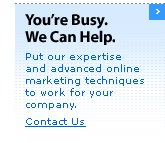|
||||||||||||
|
||||||||||||
 |
||||||||||||
|
||||||||||||
|
|
Creating a Web site involves several different tasks—architecture/strategy, copywriting, graphic design, programming, testing, etc.—in pursuit of a single goal—conversion. Yet, countless Web sites exist in which conversion seems like afterthought. Creating a Web site in which conversion lies at the heart of every page doesn’t require any technical wizardry. Instead, it just requires a deeper understanding of how people interact with Web pages.  Every Web page should have one and only one prominent call to action. In fact, most Web pages should only have one call to action period. People become very impatient when they use the Web. If you don’t make your call to action obvious, few people will see it, and fewer still will act on it. Furthermore, if you provide multiple calls to action and give them equal weight, you will minimize your conversion rate and maximize your cost of conversion. That’s a bad combination. Admittedly, some Web pages require more than one call to action. This is especially true of home pages. However, even in these situations, you should decide which call to action is the most important, and make it more prominent than all the others. In addition, keep the number of calls to action to the absolute minimum. If you find yourself creating a Web page with too many calls to action, an easy solution does exist—break that page up into as many different pages as there are calls to action. You, You, You. Not We, We, We. Every Web page should focus on the visitor’s needs, not the owner’s wants. As a result, companies should make heavy use of the second person and minimal use of the first and third person. In addition, every Web page must make its purpose and benefit clear or else it will drive visitors away. Heavy use of first person language is the most common problem on corporate Web sites. Like it or not, people are inherently selfish. They’re far more interested in themselves than in your company. Therefore, when they visit your Web site, they want to know what you can do for them, not what you think of your company. A related obstacle to conversion is unnecessary information. For example, companies often discuss a product on one massive page rather than placing the information of interest to most people on a main page and placing the other details on subordinate pages. Similarly, while animation may make sense in a few specific instances, most of the time it just gets in the way of what people want. Make Something Out of Nothing Most companies waste a golden opportunity when they design “nothing pages” for their Web site—i.e., the confirmation pages, error pages, empty search results pages that receive a great deal of traffic, much of it unintended. These pages provide an excellent vehicle for trying to persuade people to do something else on your site. You won’t hold onto everyone, but you’ll keep more people engaged than if you didn’t do anything at all. As an example, consider this site. Our home page provides you with two options—sign up for the Click-Through Report (our e-mail newsletter) or learn about our Closed-Loop Marketing process. If you sign up for our newsletter, the confirmation page tries to persuade you to learn more about our Closed-Loop Marketing process. You’re Busy. We Can Help. The Web design tips discussed above illustrate that conversion lies at the heart of our Web design philosophy. These tips represent just a few of the many tricks we have up our sleeve. Unlike other Web designers, we don’t just create attractive landing pages and Web sites. Instead, we create attractive landing pages and Web sites that convert clicks into leads, sales, and referrals. Contact us to discuss your Web design needs |
|
||||||||||
|
||||||||||||

